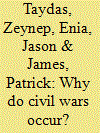| Srl | Item |
| 1 |
ID:
127626


|
|
|
|
|
| Publication |
2014.
|
| Summary/Abstract |
The biological and chemical weapon nonproliferation and disarmament regimes are often put forward as models of what the nuclear nonproliferation regime could (or should) be. But are these regimes effective? If so, is one stronger and/or more effective than the other? What is it that makes them relatively stronger than the nuclear nonproliferation regime? In this article, we return to and expand upon a framework for assessing regime health and effectiveness. We utilize this framework to engage in a comparative analysis of the chemical weapon (CW) and biological weapon (BW) nonproliferation regimes, respectively. Our analysis reveals that these two regimes are comparatively healthier than their nuclear counterpart. While some of their behavioral features might be troubling-such as the disputes over stockpile destruction of CW-these tend to be mitigated by the presence of a strong norm against possession and proliferation of both CW and BW. This norm is adequately embedded into the existing institutional features of the regimes in ways that do not exist in the nuclear nonproliferation regime.
|
|
|
|
|
|
|
|
|
|
|
|
|
|
|
|
| 2 |
ID:
108518


|
|
|
|
|
| Publication |
2011.
|
| Summary/Abstract |
The purpose of this article is to review major theoretical arguments with regard to the causes of civil war and identify problems associated with the conceptual juxtaposition of opportunity versus grievance that predominates in the field. While they are critical aspects of conflict processes, perception of opportunity and grievance as two mutually competing explanations or separate categories ultimately can limit, rather than facilitate, our understanding of civil conflicts. For example, we show that not all motives can be designated easily as deriving from one or the other. In addition, the existing dichotomous framework masks other important questions about the way that collective action is achieved in some circumstances and not others or the way that some factors seem to generate grievances at one stage, perhaps, but then an opportunity at another or vice versa. Thus the priority should be to develop an integrated, comprehensive approach that can account for fundamental aspects of complex conflict processes. We conclude by providing suggestions for future research on civil conflict.
|
|
|
|
|
|
|
|
|
|
|
|
|
|
|
|